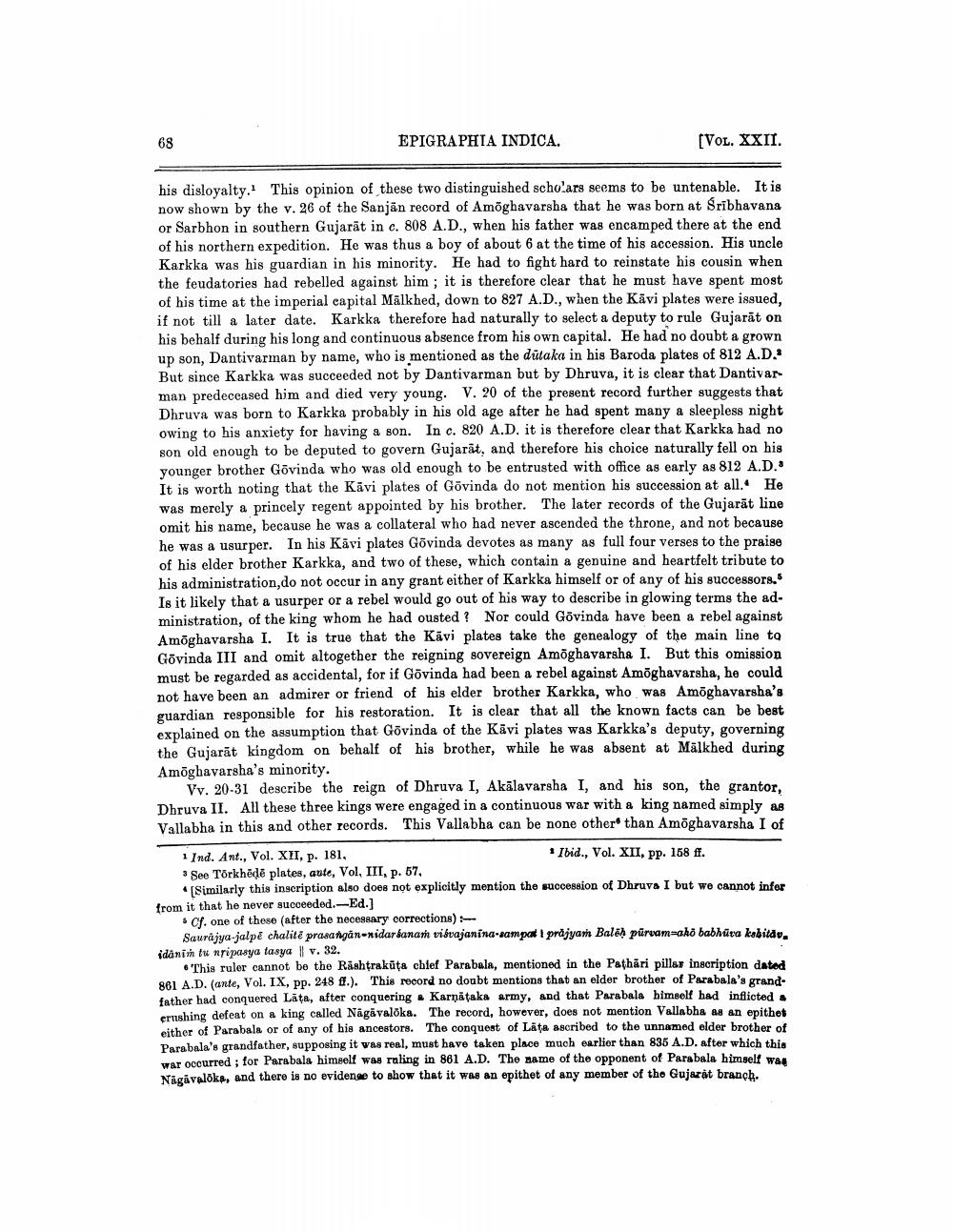________________
EPIGRAPHIA INDICA.
[VOL. XXII.
his disloyalty. This opinion of these two distinguished scholars seems to be untenable. It is now shown by the v. 26 of the Sanjān record of Amõghavarsha that he was born at Srībhavana or Sarbhon in southern Gujarāt in c. 808 A.D., when his father was encamped there at the end of his northern expedition. He was thus a boy of about 6 at the time of his accession. His uncle Karkka was his guardian in his minority. He had to fight hard to reinstate his cousin when the feudatories had rebelled against him ; it is therefore clear that he must have spent most of his time at the imperial capital Mālkhed, down to 827 A.D., when the Kävi plates were issued, if not till a later date. Karkka therefore had naturally to select a deputy to rule Gujarat on his behalf during his long and continuous absence from his own capital. He had no doubt a grown up son, Dantivarman by name, who is mentioned as the dutaka in his Baroda plates of 812 A.D. But since Karkka was succeeded not by Dantivarman but by Dhruva, it is clear that Dantivar man predeceased him and died very young. V. 20 of the present record further suggests that Dhruva was born to Karkka probably in his old age after he had spent many a sleepless night owing to his anxiety for having a son. In c. 820 A.D. it is therefore clear that Karkka had no son old enough to be deputed to govern Gujarāt, and therefore his choice naturally fell on his younger brother Govinda who was old enough to be entrusted with office as early as 812 A.D. It is worth noting that the Kāvi plates of Govinda do not mention his succession at all. He was merely a princely regent appointed by his brother. The later records of the Gujarät line omit his name, because he was a collateral who had never ascended the throne, and not because he was a usurper. In his Kävi plates Govinda devotes as many as full four verses to the praise of his elder brother Karkka, and two of these, which contain a genuine and heartfelt tribute to his administration, do not occur in any grant either of Karkka himself or of any of his successors. Is it likely that a usurper or a rebel would go out of his way to describe in glowing terms the administration, of the king whom he had ousted ? Nor could Govinda have been a rebel against Amõghavarsha I. It is true that the Kāvi plates take the genealogy of the main line to Govinda III and omit altogether the reigning sovereign Amoghavarsha I. But this omission must be regarded as accidental, for if Govinda had been a rebel against Amõghavarsha, he could not have been an admirer or friend of his elder brother Karkka, who was Amõghavarsha's guardian responsible for his restoration. It is clear that all the known facts can be best explained on the assumption that Govinda of the Kāvi plates was Karkka's deputy, governing the Gujarat kingdom on behalf of his brother, while he was absent at Mālkhed during Amõghavarsha's minority.
Vv. 20-31 describe the reign of Dhruva I, Akālavarsha I, and his son, the grantor, Dhruva II. All these three kings were engaged in a continuous war with a king named simply as Vallabha in this and other records. This Vallabha can be none other than Amöghavarsha I of
1 Ind. Ant., Vol. XII, p. 181,
Ibid., Vol. XII, pp. 158 ff. * See Torkhede plates, aute, Vol. III, p. 57,
* [Similarly this inscription also does not explicitly mention the succession of Dhruva I but we cannot infor from it that he never succeeded.-Ed.]
. Cf. one of these (after the necessary corrections)
Saurajya-jalpe chalite prasangan-nidardanam visvajanina-sampar i prajyam Balen püramaho babhuva kabitdu. idanish tu nipasya tasya | v. 32.
This ruler cannot be the Rashtrakūta chief Parabala, mentioned in the Pathari piller inscription dated 861 A.D. (ante, Vol. IX, pp. 248 ff.). This record no doubt mentions that an elder brother of Parabala's grandfather had conquered Läta, after conquering Karnataka army, and that Parabala himself had inflicted. ernshing defeat on a king called Nägāvaloks. The record, however, does not mention Vallabha as an epithet either of Parabala or of any of his ancestors. The conquest of Lata ascribed to the unnamed elder brother of Parabala's grandfather, supposing it was real, must have taken place much earlier than 835 A.D. after which this war occurred; for Parabala himself was raling in 861 A.D. The name of the opponent of Parabala himself was Nagávalóks, and there is no evidenge to show that it was an epithet of any member of the Gujarat branch.




